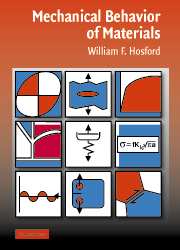Book contents
- Frontmatter
- Contents
- Preface
- Note to the Reader
- 1 Stress and Strain
- 2 Elasticity
- 3 Tensile Testing
- 4 Other Tests of Plastic Behavior
- 5 Strain-Hardening of Metals
- 6 Plasticity Theory
- 7 Strain-Rate and Temperature Dependence of Flow Stress
- 8 Slip
- 9 Dislocation Geometry and Energy
- 10 Dislocation Mechanics
- 11 Mechanical Twinning and Martensitic Shear
- 12 Hardening Mechanisms in Metals
- 13 Ductility and Fracture
- 14 Fracture Mechanics
- 15 Viscoelasticity
- 16 Creep and Stress Rupture
- 17 Fatigue
- 18 Residual Stresses
- 19 Ceramics and Glasses
- 20 Polymers
- 21 Composites
- 22 Mechanical Working
- Appendix A Miller Indices
- Appendix B Stereographic Representation of Orientations
- Index
2 - Elasticity
Published online by Cambridge University Press: 05 June 2012
- Frontmatter
- Contents
- Preface
- Note to the Reader
- 1 Stress and Strain
- 2 Elasticity
- 3 Tensile Testing
- 4 Other Tests of Plastic Behavior
- 5 Strain-Hardening of Metals
- 6 Plasticity Theory
- 7 Strain-Rate and Temperature Dependence of Flow Stress
- 8 Slip
- 9 Dislocation Geometry and Energy
- 10 Dislocation Mechanics
- 11 Mechanical Twinning and Martensitic Shear
- 12 Hardening Mechanisms in Metals
- 13 Ductility and Fracture
- 14 Fracture Mechanics
- 15 Viscoelasticity
- 16 Creep and Stress Rupture
- 17 Fatigue
- 18 Residual Stresses
- 19 Ceramics and Glasses
- 20 Polymers
- 21 Composites
- 22 Mechanical Working
- Appendix A Miller Indices
- Appendix B Stereographic Representation of Orientations
- Index
Summary
Introduction
Elastic deformation is reversible. When a body deforms elastically under a load, it will revert to its original shape as soon as the load is removed. A rubber band is a familiar example. Most materials, however, can undergo very much less elastic deformation than rubber. In crystalline materials elastic strains are small, usually less than 1/2%. It is safe for most materials, other than rubber to assume that the amount of deformation is proportional to the stress. This assumption is the basis of the following treatment. Because elastic strains are small, it doesn't matter whether the relations are expressed in terms of engineering strains, e, or true strains, ε.
The treatment in this chapter will start with the elastic behavior of isotropic materials, the temperature dependence of elasticity, and thermal expansion. Then anisotropic elastic behavior and thermal expansion will be covered.
Isotropic elasticity
An isotropic material is one that has the same properties in all directions. If uniaxial tension is applied in the x-direction, the tensile strain is ex = σx/E, where E is Young's modulus. Uniaxial tension also causes lateral strains, ey = ez = −vex, where v is Poisson's ratio.
- Type
- Chapter
- Information
- Mechanical Behavior of Materials , pp. 21 - 38Publisher: Cambridge University PressPrint publication year: 2005



